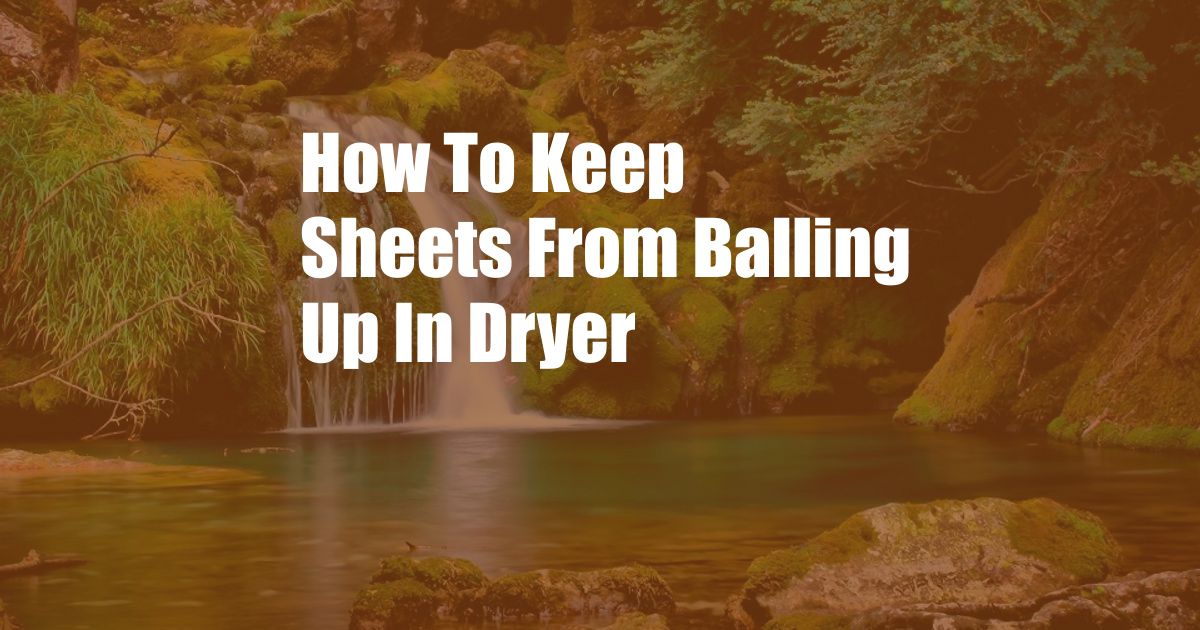
The Wrinkly Truth: Unraveling the Secrets of Preventing Sheets from Balling Up in the Dryer
Imagine the familiar scenario: you eagerly unload your freshly washed sheets from the dryer, only to find them crumpled into a tangled mess, resembling an unmade bed. This frustrating phenomenon, known as sheet balling, is a common laundry woe that can leave you feeling defeated and your bedding in need of a makeover. But fear not! We’ve gathered expert tips and insights to help you unlock the secrets of keeping your sheets smooth and free from wrinkles.
Before delving into the intricacies of sheet balling, let’s first define the culprit: static electricity. This invisible force arises during the drying process when fabrics rub against each other, causing an accumulation of electrical charges. These charges repel each other, leading to the dreaded balling effect.
Taming Static: The Key to Unwrinkled Sheets
Taming static is the cornerstone of preventing sheet balling. Here’s how you can neutralize these pesky charges:
Use Dryer Balls or Sheets: Dryer balls or sheets are lifesavers in the fight against static. Made from materials like wool or plastic, they act like tiny anti-static devices, bouncing among your laundry to separate fabrics and disrupt static build-up. Toss a few into your dryer before each load and witness the difference.
Fabric Softener: Another effective static reducer is fabric softener. Its cationic ingredients neutralize negative charges on fabrics, smoothing them out and preventing them from clinging to each other. However, use fabric softener sparingly, as excessive amounts can leave a residue on your sheets, attracting dust and even making them feel stiff.
Other Tricks of the Trade
In addition to combating static, there are other clever tricks you can employ to keep your sheets wrinkle-free:
Separate Sheets: Avoid overloading your dryer with different fabrics. Sheets, towels, and clothing generate varying amounts of static, so mixing them can lead to tangled chaos. Dedicate a load solely to your sheets to minimize static build-up.
Tumble Dry on Low Heat: High heat can worsen sheet balling as it increases static generation. Opt for low or medium heat settings, which are gentler on fabrics and reduce friction.
Remove Sheets Promptly: Don’t leave your sheets languishing in the dryer. As soon as they’re dry, remove them and fold or hang them immediately. Prolonged tumbling can contribute to wrinkles and set the stage for sheet balling.
Vinegar Rinse: Vinegar is a natural fabric softener and anti-static agent. Add a cup of white vinegar to your final rinse cycle to neutralize any remaining static and impart a subtle freshness to your sheets.
The Latest in Laundry Technology
The world of laundry has witnessed innovative advancements that can further enhance your sheet-smoothing endeavors:
Electrostatic Drying: Electrostatic dryers incorporate negative ions into the drying cycle, which actively neutralize positive charges on fabrics. This advanced technology significantly reduces static and keeps wrinkles at bay.
Steam Dryers: Steam dryers utilize steam to relax wrinkles and naturally soften fabrics. The gentle steam penetrates deep into the fibers, leaving your sheets smooth and static-free.
FAQ on Sheet Balling
Q: Why do my sheets ball up even with dryer balls?
A: Check the type of dryer balls you’re using. Plastic balls may not be as effective as wool or rubber balls. Also, ensure you’re using enough dryer balls; a recommended dosage is 2-4 balls per load.
Q: Can I use dryer sheets instead of fabric softener?
A: Yes, dryer sheets can serve as an alternative to fabric softener. However, be mindful of their potential to leave a residue on your sheets. Use them judiciously or consider switching to liquid fabric softener.
Q: Is it better to air-dry sheets to prevent balling?
A: Air-drying can be a gentler option, especially for delicate fabrics. However, air-drying may take longer and requires ample space. If you choose to air-dry, ensure your sheets are thoroughly dry before storing them to avoid mildew.
Conclusion
The battle against sheet balling is a never-ending quest for laundry enthusiasts. By understanding the science behind static and embracing the tips and expert advice outlined above, you can restore your sheets to their smooth and wrinkle-free glory. Remember to experiment with different techniques and find the combination that works best for your laundry routine. Happy laundering!
Are you ready to banish sheet balling from your laundry life? Share your experiences and any additional tips you may have in the comments below.